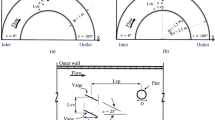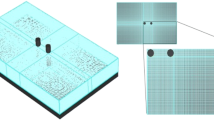Abstract
This study explored the effects of different intake positions at 45° and 90° intake angles in a 180° mild bend upon the flow pattern around a circular bridge pier using the SSIIM2 software program. Two turbulence models, the standard k–ɛ and the k–ɛ RNG, were used for numerical data validation against experimental results. Results indicated that the k–ɛ RNG turbulence model enjoyed a greater precision than the standard k–ɛ turbulence model. For all intake positions, the streamlines in the main channel, the velocity values, the average secondary flow power and the shear stress remained almost the same after the intake angle was changed from 45° to 90°. However, the streamlines in the intake channel were different. The average secondary flow power increased by about 41.2% with the intake placed in the second half of the bend compared to the first half, and it increased by 17.6% when the intake was placed in the 115° position and no piers were involved.

















Similar content being viewed by others
Abbreviations
- \(\frac{{R_{{\text{c}}} }}{B}\) :
-
The relative curvature radius
- \(B\) :
-
The channel width
- \(R_{{\text{c}}}\) :
-
The central radius
- Φ:
-
The intake position
- θ :
-
The angle of the intake channel
- d :
-
The pier diameter
- \(\delta_{ij}\) :
-
Kronecker delta
- \(\rho\) :
-
Fluid density
- \(P\) :
-
Total pressure
- \(U\) :
-
The velocity components
- \(\upsilon_{T}\) :
-
Vortex viscosity
- \(\upsilon\) :
-
The kinematic viscosity
- \(k\) :
-
The turbulence flow kinetic energy
- \(\varepsilon\) :
-
The turbulent flow kinetic energy loss
- \(Q\) :
-
The flow rate
- \(y\) :
-
The flow depth
- \(V_{m}\) :
-
The average flow velocity in the bend without pier
- \(S_{xy}\) :
-
The secondary intensity
- \(K_{{{\text{lateral}}}}\) :
-
The kinetic energy of the lateral flow
- \(K_{{{\text{total}}}}\) :
-
The kinetic energy of the main stream
- \(\tau_{{{\text{b}}^{\prime } }}\) :
-
The average shear stress in the bend without pier
- \(\tau_{{\rm b}}\) :
-
The shear stress
- \(\theta^{\prime }\) :
-
The angles from the beginning of the bend
- \(u\) :
-
The tangential velocity
- \(v\) :
-
The radial velocity
- \(w\) :
-
The vertical velocity
- \(Z_{i}^{{{\text{num}}}}\) :
-
Results of the numerical
- \(Z_{i}^{{{\text{exp}}}}\) :
-
Results of the experiment
- \(N\) :
-
Number of data
- MAE:
-
The mean absolute error
- RMSE:
-
The root mean square error
- \(R^{2}\) :
-
The coefficient of determination
- \(y^{ + }\) :
-
The ratio between turbulent and laminar influences in a cell
- \(u^{*}\) :
-
The shear velocity of the wall
- \(i\) :
-
Index for x-direction
- \(j\) :
-
Index for y-direction
References
Chiew, Y.M.; Melville, B.W.: Local scour around bridge piers. J. Hydraul. Res. 25(1), 15–26 (1987). https://doi.org/10.1080/00221688709499285
Graf, W.H.; Istiarto, I.: Flow pattern in the scour hole around a cylinder. J. Hydraul. Res. 40(1), 13–20 (2002). https://doi.org/10.1080/00221680209499869
Emami, Y.; Salamatian, S.A.; Ghodsian, M.: Scour at cylindrical bridge pier in a 180° channel bend. In Proceedings 4th International Conference on Scour and Erosion. pp. 256–262. Tokyo, Japan, (2008).
Kumar, U.C.; Kothyari, K.G.; Ranga, R.: Flow structure and scour around circular compound bride piers: a review. J. Hydro-Environ. Res. 6(4), 251–265 (2012). https://doi.org/10.1016/j.jher.2012.05.006
Das, S.; Mazumdar, A.: Turbulence flow field around two eccentric circular piers in scour hole. Int. J. River Basin Manag. 13(3), 343–361 (2015). https://doi.org/10.1080/15715124.2015.1012515
Vaghefi, M.; Ghodsian, M.; Salimi, S.: The effect of circular bridge piers with different inclination angles toward downstream on scour. Sadhana 41, 75–86 (2016). https://doi.org/10.1007/s12046-015-0443-x
Gautam, P.; Eldho, T.I.; Mazumder, B.S.; Behera, M.R.: Experimental study of flow and turbulence characteristics around simple and complex piers using PIV. Exp. Therm. Fluid Sci. 100, 193–206 (2019). https://doi.org/10.1016/j.expthermflusci.2018.09.010
Moghanloo, M.; Vaghefi, M.; Ghodsian, M.: Experimental investigation on the effect of increasing the collar thickness on the flow pattern around the oblong pier in 180° sharp bend with balanced bed. J. Appl. Fluid Mech. 13(1), 245–260 (2020). https://doi.org/10.29252/jafm.13.01.30164
Dehghan, D.; Vaghefi, M.; Ghodsian, M.: The effect of collar width ratio on the flow pattern around oblong pier in bend. Water Supply 21(8), 4130–4144 (2021). https://doi.org/10.2166/ws.2021.165
Keshavarz, A.; Vaghefi, M.; Ahmadi, G.: Investigation of flow pattern around rectangular and oblong piers with collar located in a 180° sharp bend. Sci. Iran. 28(5), 2479–2492 (2021). https://doi.org/10.24200/SCI.2021.55320.4169
Das, R.; Mishra, S.C.; Ajith, M.; Uppaluri, R.: An inverse analysis of a transient 2-D conduction–radiation problem using the lattice Boltzmann method and the finite volume method coupled with the genetic algorithm. J. Quant. Spectrosc. Radiat. Transf. 109(11), 2060–2077 (2008). https://doi.org/10.1016/j.jqsrt.2008.01.011
Das, R.: A simulated annealing-based inverse computational fluid dynamics model for unknown parameter estimation in fluid flow problem. Int. J. Comput. Fluid Dyn. 26(9–10), 499–513 (2012). https://doi.org/10.1080/10618562.2011.632375
Das, R.: Inverse analysis of Navier–Stokes equations using simplex search method. Invers. Probl. Sci. Eng. 20(4), 445–462 (2012). https://doi.org/10.1080/17415977.2011.629046
Vaghefi, M.; Safarpoor, Y.; Hashemi, S.S.H.: Effects of distance between the T-shaped spur dikes on flow and scour patterns in 90 bend using the SSIIM model. Ain Shams Eng. J. 7(1), 31–45 (2016). https://doi.org/10.1016/j.asej.2015.11.008
Vaghefi, M.; Safarpoor, Y.; Akbari, M.: Numerical investigation of flow pattern and components of three-dimensional velocity around a submerged T-shaped spur dike in a 90° bend. J. Cent. South Univ. 23(11), 2984–2998 (2016). https://doi.org/10.1007/s11771-016-3362-z
Alemi, M.; Maia, R.: Numerical simulation of the flow and local scour process around single and complex bridge piers. Int. J. Civil Eng. 16(5), 475–487 (2018). https://doi.org/10.1007/s40999-016-0137-8
Vaghefi, M.; Faraji, B.; Akbari, M.; Eghbalzadeh, A.: Numerical investigation of flow pattern around a T-shaped spur dike in the vicinity of attractive and repelling protective structures. J. Braz. Soc. Mech. Sci. Eng. 40(2), 1–15 (2018). https://doi.org/10.1007/s40430-017-0954-y
Vaghefi, M.; Ahmadi, A.; Faraji, B.: Variation of hydraulic parameters with different wing of a T-shape spur dike in bend channels. J. Cent. South Univ. 25(3), 671–680 (2018). https://doi.org/10.1007/s11771-018-3770-3
Asadollahi, M.; Vaghefi, M.; Akbari, M.: Effect of the position of perpendicular pier groups in a sharp bend on flow and scour patterns: numerical simulation. J. Braz. Soc. Mech. Sci. Eng. 42(8), 1–15 (2020). https://doi.org/10.1007/s40430-020-02503-2
Vaghefi, M.; Moradi, S.; Abdi Chooplou, C.: Numerical study of bed topography variations owing to placement of triad series of vertical bridge piers installed in a 180° bend with different relative radii using SSIIM numerical model. Iran. J. Sci. Technol. Trans. Civil Eng. 45(3), 1971–1988 (2021). https://doi.org/10.1007/s40996-020-00559-7
Neary, V.S.; Sotiropoulos, F.; Odgaard, A.J.: Three-dimensional numerical model of lateral-intake inflows. J. Hydraul. Eng. 125(2), 126–140 (1999). https://doi.org/10.1061/(ASCE)0733-9429(1999)125:2(126)
Ramamurthy, A.S.; Qu, J.; Vo, D.: Numerical and experimental study of dividing open-channel flows. J. Hydraul. Eng. 133(10), 1135–1144 (2007). https://doi.org/10.1061/(ASCE)0733-9429(2007)133:10(1135)
Esmaeili Varaki, M.; Farhoudi, J.; Walker, D.: Study of flow structure and sediment entry to a lateral intake. In Proceedings of the Institution of Civil Engineers-Water Management. 164(7), 347–360 (2011). Thomas Telford Ltd. https://doi.org/10.1680/wama.2011.164.7.347
Merufinia, E.; Asnaashari, A.: Numerical simulation of velocity distribution in the river lateral intake using the SSIIM2 numerical model. Cumhuriyet Üniversitesi Fen Edebiyat Fakültesi Fen Bilimleri Dergisi 36(3), 1473–1486 (2015)
Karami, H.; Farzin, S.; Sadrabadi, M.T.; Moazeni, H.: Simulation of flow pattern at rectangular lateral intake with different dike and submerged vane scenarios. Water Sci. Eng. 10(3), 246–255 (2017). https://doi.org/10.1016/j.wse.2017.10.001
Moradinejad, A.; Saneie, M.; Ghaderi, A.; Shahri, S.M.Z.: Experimental study of flow pattern and sediment behavior near the intake structures using the spur dike and skimming wall. Appl. Water Sci. 9(8), 1–11 (2019). https://doi.org/10.1007/s13201-019-1069-7
Farshidnia, S.; Saneie, M.; Hajikandi, H.; Rostami, M.: Experimental investigation of impact of length and height of parallel skimming walls on controlling inlet sediment to lateral intake. Water Supply 20(3), 997–1005 (2020). https://doi.org/10.2166/ws.2020.023
Baltazar, J.; Alves, E.; Bombar, G.; Cardoso, A.H.: Effect of a submerged vane-field on the flow pattern of a movable bed channel with a 90° lateral diversion. Water 13(6), 828 (2021). https://doi.org/10.3390/w13060828
Refaey, M.A.; Abdul-Muttalib, M.A.; Khater, A.E.H.; Dewedar, A.K.: Hydraulic impact of intake slope and entrance level on flow uniformity. Al-Azhar Univ. Civil Eng. Res. Mag. 43(2), 263–271 (2021)
Novak, P.; Moffat, A.I.B.; Nalluri, C.; Narayanan, R.: Hydraulic Structures. CRC Press (2007)
Dehghani, A.A.; Ghodsian, M.; Suzuki, K.; Alaghmand, S.: Local scour around lateral intakes in 180° curved channel. In Advances in Water Resources and Hydraulic Engineering. Berlin, Heidelberg. pp. 821–825 (2009). https://doi.org/10.1007/978-3-540-89465-0_144
Beygipoor, G.H.; Bajestan, M.S.; Kaskuli, H.A.; Nazari, S.: The effect of distance from submerged vanes to the intake at different angles of vanes on controlling the sediment entering the intake branching from a 90 convergent bend. Int. J. Farm. Allied Sci. 2(17), 591–598 (2013)
Tavakoli, K.; Montaseri, H.; Omidvar, P.; Evangelista, S.: Numerical simulation of sediment transport in a U-shaped channel with lateral intake: effects of intake position and diversion angle. Int. J. Mod. Phys. C 30(09), 1950071 (2019). https://doi.org/10.1142/S0129183119500712
Montaseri, H.; Tavakoli, K.; Evangelista, S.; Omidvar, P.: Sediment transport and bed evolution in a 180° curved channel with lateral intake: numerical simulations using Eulerian and discrete phase models. Int. J. Mod. Phys. C 31(08), 2050113 (2020). https://doi.org/10.1142/S0129183120501132
Bazarov, D.; Markova, I.; Norkulov, B.; Vokhidov, O.: Hydraulic aspects of the layout of head structures during water intake from lowland rivers. In IOP Conference Series: Materials Science and Engineering. 1015(1), 012041 (2021). https://doi.org/10.1088/1757-899X/1015/1/012041
Montaseri, H.; Ghodsian, M.; Shafieifar, M.; Salehi, N.S.; Dehghani, A.A.: Experimental investigation of 3D flow field and scouring in a 180° bend rectangular channel with a lateral intake. J. Agric. Sci. Nat. Resour. 15(2), 225–240 (2008)
Leschziner, M.A.; Rodi, W.: Calculation of strongly curved open channel flow. J. Hydraul. Div. 105(10), 1297–1314 (1979)
Amini, A.; Parto, A.A.: 3D numerical simulation of flow field around twin piles. Acta Geophys. 65(6), 1243–1251 (2017). https://doi.org/10.1007/s11600-017-0094-x
Olsen, N.R.B.: A three dimensional numerical model for simulation of sediment movements in water intakes with multiblock option. Online User’s manual: Norwegian University of Science and Technology, Trondheim, Norway (2007).
Olsen, N.R.B.: Computational Fluid Dynamics in Hydraulic and Sedimentation Engineering. Class notes, Norwegian University of Science and Technology, Trondheim (1999)
Safaripour, N.; Vaghefi, M.; Mahmoudi, A.: Experimental study of the effect of submergence ratio of double submerged vanes on topography alterations and temporal evaluation of the maximum scour in a 180° bend with a bridge pier group. Int. J. River Basin Manag. (2020). https://doi.org/10.1080/15715124.2020.1837144
Akbari, M.; Vaghefi, M.; Chiew, Y.M.: Effect of T-shaped spur dike length on mean flow characteristics along a 180° sharp bend. J. Hydrol. Hydromech. 69(1), 98–107 (2021). https://doi.org/10.2478/johh-2020-0045
Blanckaert, K.; Graf, W.H.: Mean flow and turbulence in open-channel bend. J. Hydraul. Eng. 127(10), 835–847 (2001). https://doi.org/10.1061/(ASCE)0733-9429(2001)127:10(835)
Shukry, A.: Flow around bends in an open flume. Trans. Am. Soc. Civil Eng. ASCE 115, 751–779 (1950)
Author information
Authors and Affiliations
Corresponding author
Rights and permissions
Springer Nature or its licensor (e.g. a society or other partner) holds exclusive rights to this article under a publishing agreement with the author(s) or other rightsholder(s); author self-archiving of the accepted manuscript version of this article is solely governed by the terms of such publishing agreement and applicable law.
About this article
Cite this article
Niknezhad, F., Mahmoudi, A. & Vaghefi, M. A Study of the Effects of a Lateral Intake’s Positions on the Flow Pattern Around a Bridge Pier in a 180° Bend Using SSIIM2. Arab J Sci Eng 48, 12903–12929 (2023). https://doi.org/10.1007/s13369-023-07617-y
Received:
Accepted:
Published:
Issue Date:
DOI: https://doi.org/10.1007/s13369-023-07617-y




